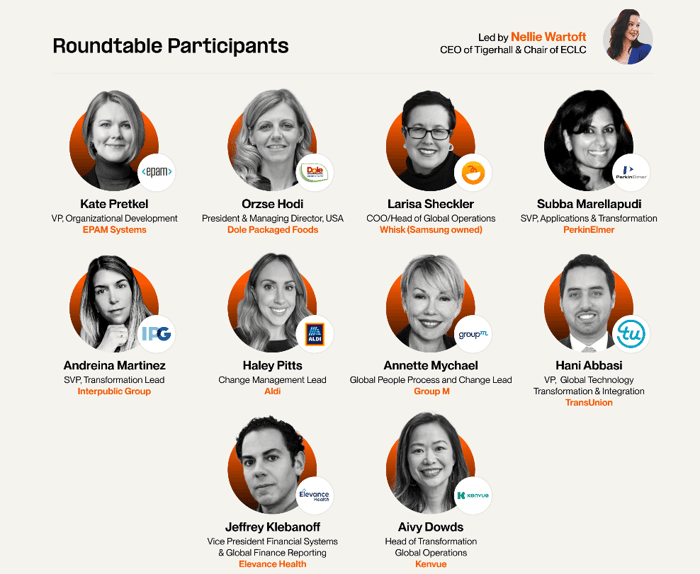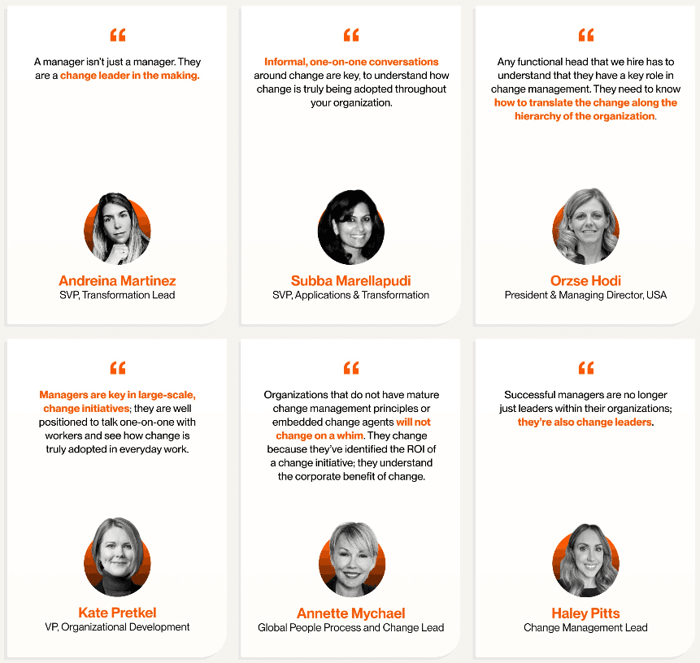Organizational change is a complex endeavor that requires thoughtful planning, strategic communication, and effective leadership. In a recent Executive Council for Leading Change (ECLC) roundtable discussion, senior executives from various industries came together to share insights and strategies for involving employees in the change process. The following brief presents a comprehensive analysis of the conversation, highlighting key strategies, successful approaches, common challenges, and notable quotes from the discussion.
This roundtable was held on April 12th, 2024.

5 Key Strategies for Navigating Organizational Change with Employees
Feedback Loops
Annette pointed out that feedback loops not only help in engaging employees in a change process but also creates golden opportunities for dialogue around change. This enables continuous learning and adjustments around change strategies, fostering a culture of adaptability and innovation throughout the organization.
Inclusive Decision-Making
Kate and Larisa agreed that involving employees in shaping the change initiative fosters ownership and commitment. When asked to what extent they are currently involving employees in change processes (on a scale from 0 to 10, with 0 being not at all and 10 being in everything they do), 66% of all roundtable members answered 5 or above and no members answered 0 or 1. This shows the deliberate intent and thought put into involving employees in change processes by ECLC members, fostering progressive buy-in throughout their organizations.
AI Empowerment
By harnessing the power of AI, organizations can quickly unearth nuanced patterns in workplace sentiment, distilling extensive feedback from thousands of employees into actionable intelligence. Additionally, AI empowers change leaders to refine their messaging to suit diverse audiences, fostering resonance and alignment throughout their organization.
Change Leadership Development
Subba pointed out that change leadership isn’t a skill reserved for one department but an important toolset for leaders of all levels and all departments. By equipping leaders with change leadership skills, it helps different departments and teams navigate change effectively.
Strategic, Targeted Communication
Strategic and engaging communications were emphasized as essential for conveying the rationale, vision, and expectations related to change initiatives. When polled at which stage they thought it was most ideal to start communicating and involving employees in the change processes, 60% of members agreed on the scoping phase, where the change is first shaped and elaborated on. However, they noted that the ideal stage for employee involvement greatly depends on the nature of the change initiative itself. Other popular choices were before deciding whether a change is needed, when it is communicated throughout the wider organization, and at the start of the implementation. All participants agreed that employee input should start happening no later than at the start of implementation. Moreover, they emphasized that the involvement of different employee groups may vary, with certain groups being integral to the initial processes while others might not be. Jeffrey also noted the importance of translating technical jargon into WIIFM conversations, where stakeholders from different backgrounds can find alignment. Effective communication helps build trust and clarity throughout an organization.
5 Successful Approaches and Tactics for Involving Employees in the Change Process
ECLC members were asked which methods have worked best for them, in successfully involving employees in change processes. Here are the top results of this multiple choice question:

The importance of implementing strategic communication plans that are tailored to the needs and preferences of different employee groups cannot be understated, by utilizing various channels and formats to ensure maximum reach and comprehension. Engaging communications can include storytelling, visuals, and interactive elements to capture employees' attention and foster buy-in for the change initiative.

Create formal mechanisms for gathering feedback from employees at all levels of the organization throughout the change process. This can involve regular surveys, focus groups, or feedback sessions designed to solicit insights, address concerns, and make adjustments as needed based on employee input. By establishing feedback loops, organizations can demonstrate a commitment to listening to employees' voices and incorporating their perspectives into decision-making processes.

Provide targeted training and support for leaders & managers to equip them with the skills, knowledge, and resources needed to effectively lead their teams through change. This may involve workshops, coaching sessions, or mentoring programs focused on change management principles, communication techniques, and conflict resolution strategies. By investing in enabling leadership and managers, organizations can empower them to serve as champions of change and facilitate smoother transitions within their teams.

Incorporate success stories and examples of positive outcomes resulting from the change initiative into communication materials and meetings. By highlighting these successes, organizations can inspire confidence and motivation among employees, demonstrating the tangible benefits of embracing change and encouraging continued participation and support.

Schedule regular one-on-one meetings between employees and their supervisors or managers to provide individualized support, address concerns, and offer guidance throughout the change process. These meetings offer an opportunity for open dialogue, clarification of expectations, and personalized assistance, fostering a sense of trust and accountability between employees and their leaders. Additionally, team meetings can be utilized to provide updates, address common questions or challenges, and reinforce key messages related to the change initiative, ensuring alignment and understanding across the organization.
4 Common Challenges Faced
Role Clarity and Expectations
Challenges related to role clarity and expectations were mentioned, especially when individuals are given managerial titles without the necessary skills or support for effective change leadership. Individuals may move up the echelons of their respective organizations, through seniority and skills; however, they are not always equipped with leadership skills that will help them manage teams effectively through change.
Resource Constraints
Limited time, resources, and bandwidth hinder the effective involvement of employees in the change process, highlighting the need for adequate support and investment. When asked what’s the hardest part about involving employees in change, 44% of members cited the issue of limited time. This was only surpassed in the poll by the wider issue that employees don’t always have the wider business context and understanding which then lead to certain change initiatives. Change initiatives risk failing when employees are told to change but are not given enough time, resources, or context to implement these initiatives within their daily work. That’s where tools (like Tigerhall) offer new possibilities for engagement, by offering bite-sized content that fits within the time and bandwidth of employees as they navigate change processes.
Communication Discrepancies and Group Understanding
When polled about the hardest part about involving employees in change, members also brought up issues around communication discrepancies and overall group understanding. Audience segmentation is often used to ensure that different audiences hear WIIFM messages and receive the right context around change processes. However, difficulties can arise in discerning which groups require specific information and to what extent, especially in larger or multifaceted organizations where diverse teams may have unique concerns or impacts from the impending change. Without a clear differentiation and understanding of these needs, targeted communication efforts can fall short, leaving certain groups feeling overlooked or uninformed. Additionally, each department may interpret the change differently, leading to inconsistencies in messaging and comprehension. This lack of uniformity in communication can create confusion and resistance among employees, hindering the overall success of the change initiative. Addressing these obstacles necessitates a concerted effort to tailor communication strategies to the specific needs of each group, foster a culture of transparency and collaboration, and provide ongoing support to ensure consistent understanding and alignment across the organization.
Limitations of Hackathons and Ideation Sessions
While hackathons and ideation sessions can be valuable tools for fostering creativity and generating innovative ideas, they may not always be the most effective way of involving employees in a change process. One limitation is that these sessions often attract only a subset of employees, typically those who are already inclined towards innovation or have the bandwidth to participate. This can result in a lack of diversity in perspectives and insights, potentially overlooking valuable input from other employee groups who may be directly impacted by the change. Moreover, the time-limited and high-pressure nature of hackathons may not allow for thorough exploration or consideration of complex issues related to the change initiative. Additionally, without proper follow-up and integration of ideas generated during these sessions into the broader change strategy, employees may perceive them as superficial or disconnected from the actual implementation process. As such, while hackathons and ideation sessions can be beneficial for generating ideas, they should be complemented with other engagement strategies to ensure comprehensive involvement and alignment of employees throughout the change process.

In summary, this roundtable discussion underscored the intricate nature of organizational change and the imperativeness of involving employees in this type of process. Through the collaborative insights of senior executives across diverse industries, key strategies emerged, such as the need for feedback loops and inclusive decision-making. It was found that effective change leadership transcends the efforts of one department and must be replicated throughout departments, throughout the hierarchy of an organization.
The Executive Council for Leading Change
The Executive Council for Leading Change (ECLC) is a global organization that brings executives together to redefine the landscape of organizational change and transformation. Our council's aim is to advance strategic leadership expertise in the realm of corporate change by connecting visionary leaders. It's a place where leaders responsible for significant change initiatives can collaborate, plan, and create practical solutions for intricate challenges in leading large organizations through major shifts.
In a world where change is constant, we recognize its crucial role in driving business success. ECLC’s mission is to create a community where leaders can excel in guiding their organizations through these dynamic times.
Interested in joining ECLC? Learn the membership criteria and sign-up here.
To download this executive brief, click here.

